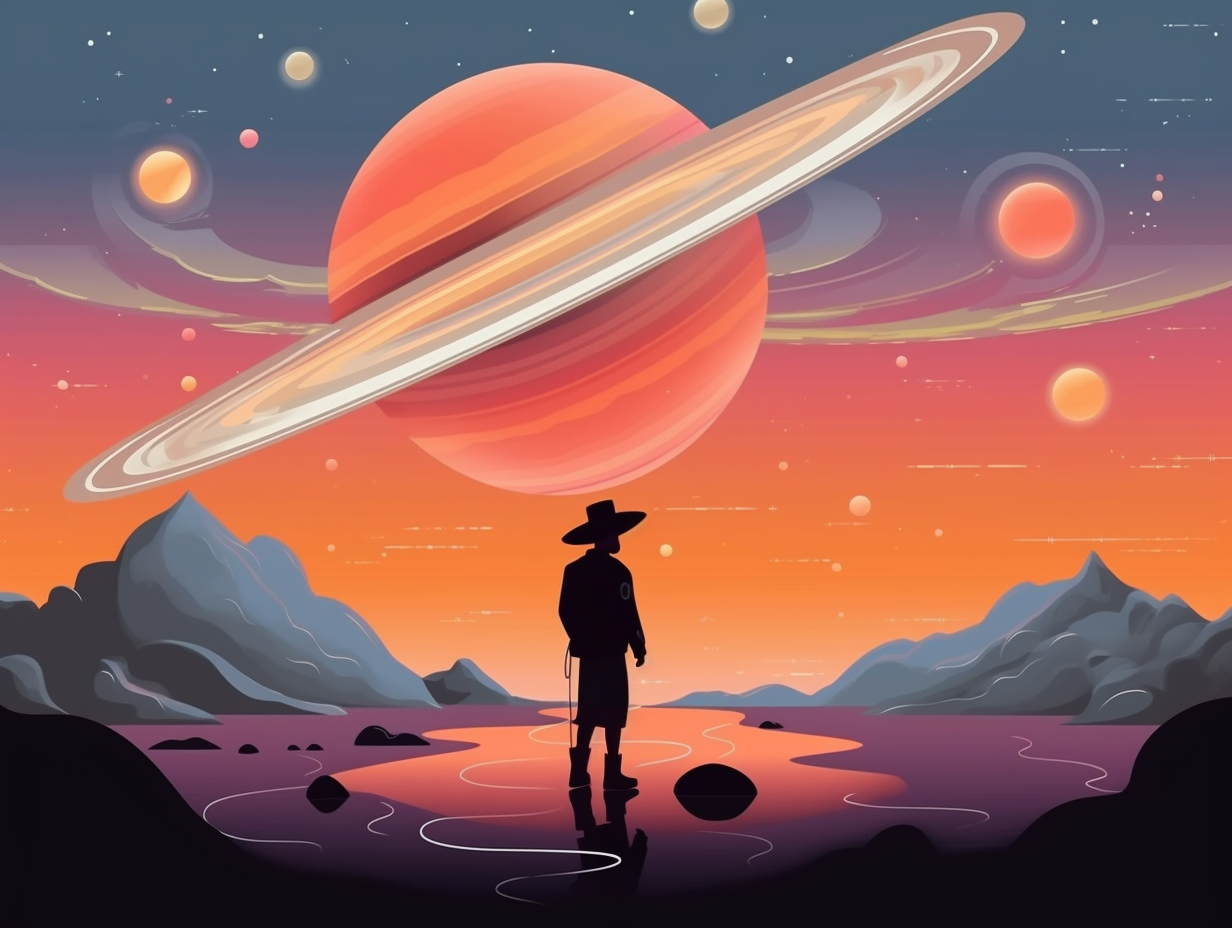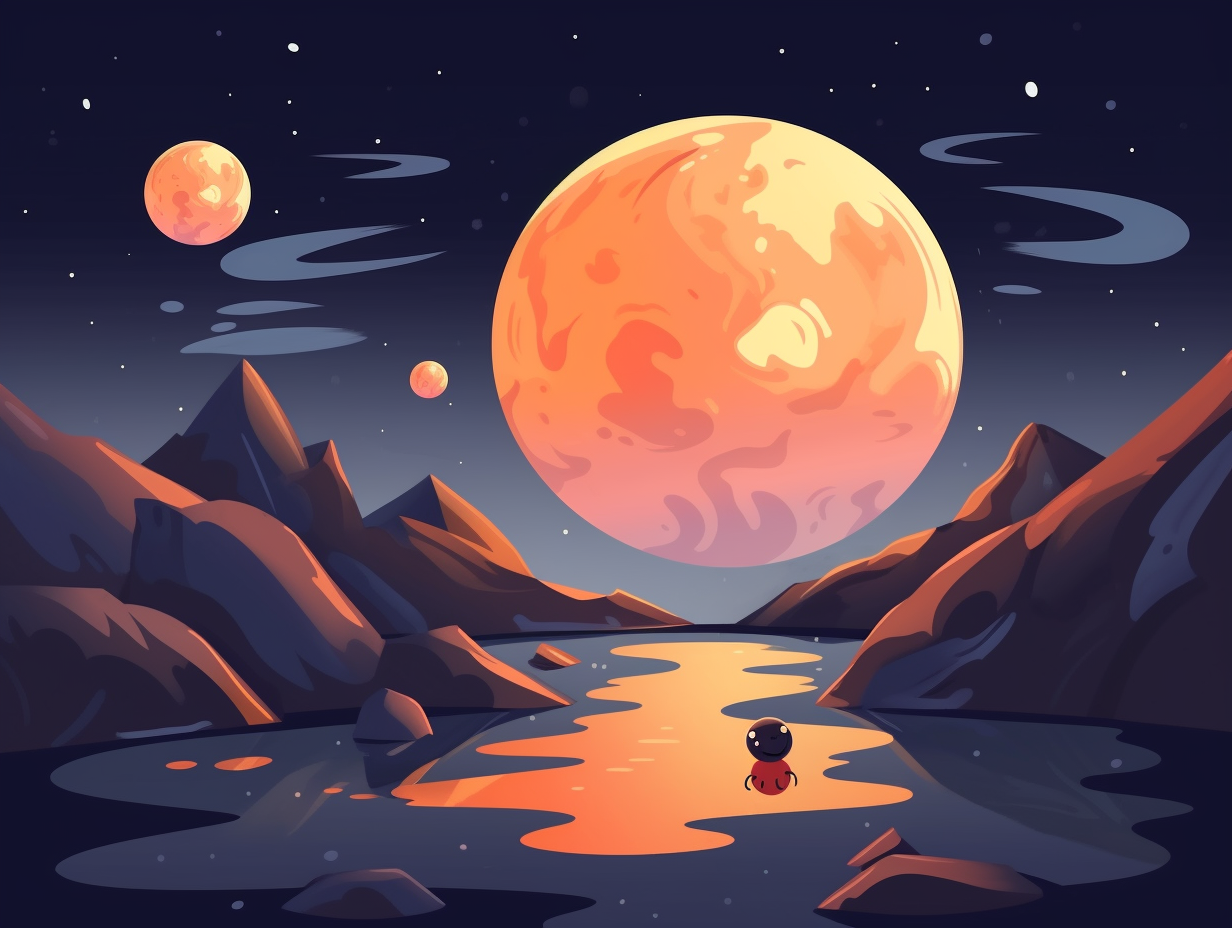Discover the Unknown: Top 25 Fun and Fascinating Facts About Neptune

1. Celestial Hide-and-Seek Champion
In a planetary game of "Where's Waldo?", Neptune played coy until a couple of celestial mathematicians cracked the code and pinpointed its hideout: Using the Titius-Bode law and Laplace's perturbation theory, John Couch Adams and Urbain Le Verrier predicted Neptune's location, leading to its discovery in 1846 by Johann Galle and Heinrich Louis d'Arrest, proving that celestial mechanics can indeed help us find elusive planets.
Source => pubs.aip.org
2. Methane's Monday Blues
Neptune must have felt really blue after being hit with a serious case of the "Monday blues": The planet's signature shade is actually caused by methane gas in its upper atmosphere, which absorbs red light from the sun and reflects blue light, giving Neptune its stunning appearance.
Source => coolcosmos.ipac.caltech.edu

Did you know that Uranus spins like a cosmic breakdancer with an unusual tilt, causing decades-long seasons due to an early-life collision? Discover more about this quirky gas giant!
=> Fun Facts about Uranus
3. Windiest Party in the Solar System
Hold onto your hats, folks: Neptune's throwing the windiest party this side of the Milky Way! Seriously though: Neptune boasts the strongest sustained winds in the Solar System, with speeds reaching 2,100 kilometers per hour and temperatures at a chilling -218 degrees Celsius atop its clouds, making it one of the coldest places imaginable.
Source => en.wikipedia.org
4. Neptune's Roman Horse Racing Fanatic
Old man Neptune wasn't just a Poseidon wannabe, he was a horse-racing fanatic who rubbed shoulders with his Roman pals by cheering for the charioteers: A genuine fan of land and sea, Neptune was worshipped by Romans, shared victory secrets with the naval goddess Salacia, and dominated the freshwaters with no sibling rivalry drama with his Greek counterpart Poseidon.
Source => en.wikipedia.org

5. Punctual Planetary Party Host
Who needs a watch when you've got Neptune? Don't let the mysterious blue planet fool you; like an eager party host trying to squeeze in as many celebrations as possible, Neptune is a stickler when it comes to punctuality: In fact, scientists have determined that its day length is approximately 15 hours, making it the eighth longest day in the solar system—a record achieved without any spacecraft visiting Neptune since Voyager 2 in 1989. Talk about spinning the night away!
Source => thoughtco.com
6. Winter Wardrobe Wonders
Neptune's winter wardrobe must be endless, given that it has the solar system's iciest temperatures to contend with: This frosty giant boasts temperatures plummeting to a shivering -373°F (-225°C), making it one of the coldest planets, rivaled only by Uranus.
Source => a-z-animals.com
7. Speedy Winds of Neptune
Who needs The Flash when Neptune's got the real need for speed: this distant blue wonder boasts the most powerful winds in our Solar System, zooming at breakneck speeds of up to 2,100 km/h (1,300 mph)!
Source => en.wikipedia.org
8. Moon Heist: Triton's Tale
In a true "mooned" heist of astronomical proportions: Triton, Neptune's largest satellite, was not originally formed in orbit around the big blue; no, this cunning moon snuck in and was gravitationally captured after Neptune's OG gig went kaput – now flaunting a retrograde orbit and unique incline that sets it apart from the rest.
Source => en.wikipedia.org
9. Coldest Planet Showdown
If Neptune were a contestant on a cold temperature game show, it would brrr-eeze through the competition and sweep all the frosty challenges away: The coldest planet in the Solar System, Neptune boasts average temperatures of around -200 degrees Celsius and the most ferocious winds, with gusts reaching a whirlwind 1,200 miles per hour.
Source => coolcosmos.ipac.caltech.edu

10. Great Dark Spot: Storm Chaser Edition
Listen up, space enthusiasts and storm chasers: Neptune's the ultimate celestial party crasher with its on-again-off-again fad, the Great Dark Spot! This Earth-sized storm, first spotted by Voyager 2 in 1989, rocks winds up to 2,100 kilometers per hour and morphs mysteriously every couple of years, leaving scientists marveling at its stormy swagger.
Source => en.wikipedia.org
11. Godfather of Gas Giants
Neptune: the Godfather of Gas Giants, sinking to new depths – quite literally. You see, if you put this big blue bad boy in a cosmic bathtub, unlike its cousin Saturn, it would sink faster than a wiseguy in concrete shoes: Neptune's density is a whopping 1.639 g/cm, making it the densest gas giant in our solar system and boasting a mass 1.2 times that of Uranus, despite its smaller size. The secret to this heavy mob boss's mass? A larger, rock-riddled core compared to its rival Uranus.
Source => planetfacts.org
12. Distant Blue Road Trip
Neptune, the solar system's shy little sibling hiding in the far corner of the cosmic playground: This distant blue planet is actually about 2.8 billion miles away from the Sun, or 30 astronomical units (AUs) – so if you're thinking of taking a space road trip to visit, you better pack a hefty load of snacks for the 12-year-long journey, made possible by current spacecraft technology!
Source => a-z-animals.com
13. Gravity's Second-Strongest Giant
Hold on to your hats and put on some extra weights, because Neptune's gravity is no laughing matter: With a surface gravity that only bows down to Jupiter, Neptune firmly secures its spot as the second-strongest giant in our celestial neighborhood, despite having a notably lower mass.
Source => space.com
14. Triton's Rebellious Retro Orbit
Neptune's largest moon, Triton, didn't just go rogue, it went retro: Triton orbits Neptune in the opposite direction of the planet's rotation, making it the only large moon in the Solar System to sport this celestial rebellious streak.
Source => en.wikipedia.org

15. Geologically Active Triton Geysers
Triton, the rebellious teenager of Neptune's moons, decided to swim against the current and take the road less traveled: Voyager 2 discovered in 1989 that Triton is the only large moon in the solar system boasting a retrograde orbit, defying its planet's rotation like a cosmic non-conformist.
Source => cnn.com
16. Mooning with Triton
Triton's got ice in its veins – and geysers to boot: Neptune's largest moon boasts a chilly nitrogen surface, an active icy geology, and distinctive geysers that spout sublimated nitrogen gas into its unbelievably thin atmosphere.
Source => en.wikipedia.org
17. Neptune: Ice in its Veins
Triton, Neptune's moon, must have felt left out when naming all the temperature records after Mercury: it claimed the title of the "coldest spot in town"! The serious reveal: boasting temperatures plummeting to a frosty -391 degrees Fahrenheit, Triton also surprises us with geologically active geysers of frozen nitrogen and the unique honor of being the only moon in the solar system to rebelliously orbit in the opposite direction of its planet's rotation.
Source => cnn.com
18. Neptune: Lopsided Orbit Trendsetter
If Neptune were a party guest, it would be that mysterious friend who stays at the edge of the room, keeping just out of reach and luring you in with exotic tales: The blue titan sits at a staggering distance from the Sun, about seven times farther than Earth, and glides along a lopsided orbit that stretches and tilts to unforeseen lengths, adding a sense of intrigue to our solar neighborhood's dynamics.
Source => science.org
19. The Extended Season 40-Earth-Year Box Set
Neptune's got a serious case of the seasons, lasting longer than a box set of your favorite sci-fi series: With a seasonal cycle that spans 40 Earth years, Neptune's southern cloud bands have widened and brightened due to solar heating, causing weather changes akin to our own planet, including storms with winds up to 1500 kilometers per hour – all while being 40 times further from the sun!
Source => newscientist.com
20. Mathematical Prognosticator Neptune
Neptune, the Beyoncé of planets, decided to show up fashionably late to the solar system runway: the gas giant was the first planet to be discovered by mathematical predictions rather than direct observation in 1846, all thanks to the mathematical prowess of John Couch Adams and Urbain Jean Joseph Le Verrier.
Source => historyofinformation.com
21. Rapunzel's Sparkly Diamond Supply
Ever wondered where Rapunzel could get a never-ending supply of sparkly bling? Look no further than Neptune's very own diamond showers: Diamonds as big as pebbles fall continuously into Neptune's interior, releasing gravitational energy that warms the planet from the inside out, and may contribute to its magnetic field and atmospheric circulation.
Source => osr.org
22. Celestial Hide-and-Seek Redux
Neptune, the ultimate celestial hide-and-seek champion, spent centuries playing peekaboo with astronomers like a cosmic Waldo: Its existence was first noted by Galileo in 1613, who mistook it for a star, and later by Jérôme Lalande in 1795 and John Herschel in 1830, but it wasn't until 1846 when Urbain Le Verrier's mathematical predictions finally led to its official discovery as a planet by Johann Gottfried Galle.
Source => en.wikipedia.org
23. Neptune's Cosmic Sock-Spinning Wind
Hold onto your hats and tie down your toupees: Neptune's got wind that'll knock your socks off and spin them around the solar system! The serious scoop: This far-out planet boasts the strongest winds in all of the cosmos, clocking in at a whopping 1,200 miles per hour, thanks to its tilted axis and a serious case of solar separation anxiety.
Source => space.com
24. Neptune's Supersonic Blockbuster
If Neptune's weather forecast were a blockbuster movie, it'd be called "Winds of Mass Destruction; Supersonic Edition": The planet boasts incredibly fierce storms, with wind speeds reaching a mind-blowing 1,305 miles per hour, all thanks to its internal heating - a curious fact, given its substantial distance from the sun. These monstrous gales create dramatic spots reminiscent of Jupiter's notorious Great Red Spot, but when it comes to Neptune's storms, they're masters of hide and seek, vanishing and reemerging every few years.
Source => space.com
25. Meteorological Rave Extravaganza
Hold on to your hats, ladies and gentlemen! Neptune is hosting a meteorological rave like no other, dishing out winds with more gusto than a millennial's spin class: Neptune's winds can hit a whopping 1500+ mph, making them the strongest in the solar system, as observed by NASA's Voyager space probe, with weather patterns so extreme that they have yet to break the sound barrier due to Neptune's sonic speed ranging between 600-740 m/s.
Source => reddit.com
Related Fun Facts




















